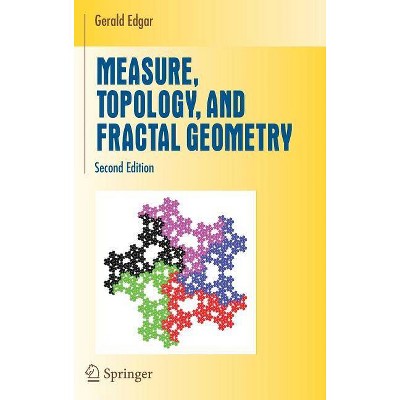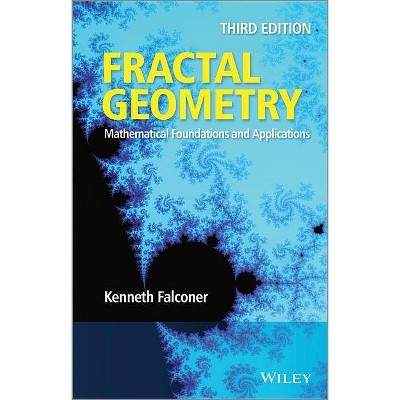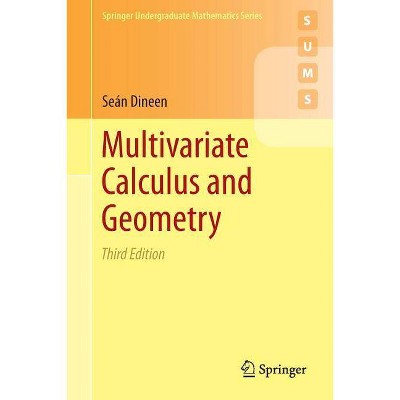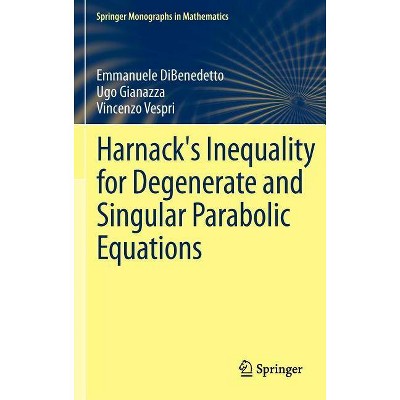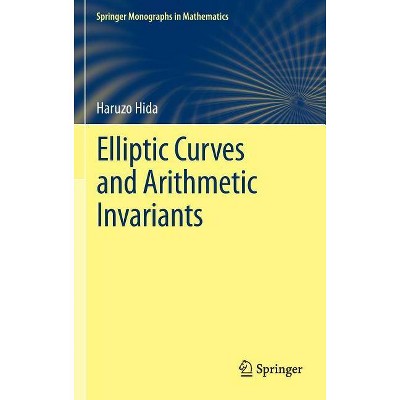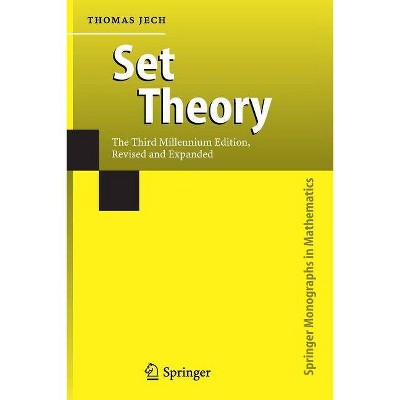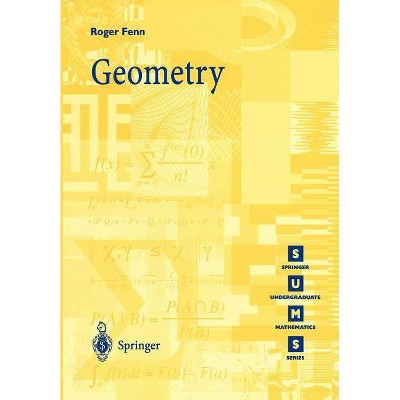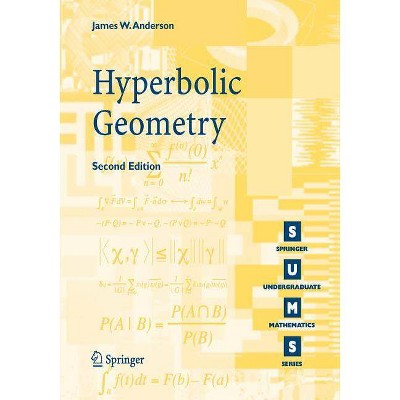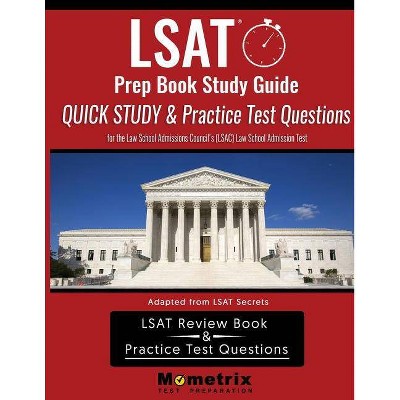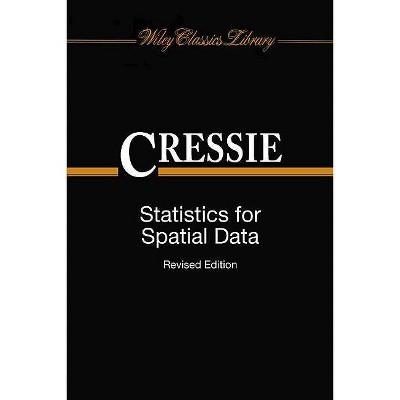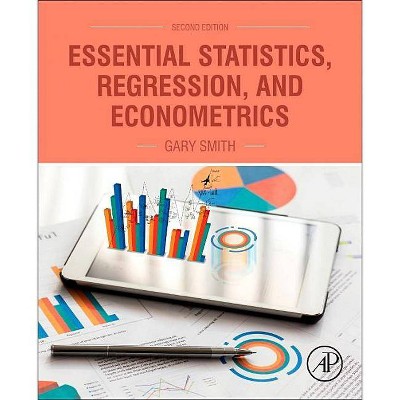Fractal Geometry, Complex Dimensions and Zeta Functions - (Springer Monographs in Mathematics) 2nd Edition (Hardcover)
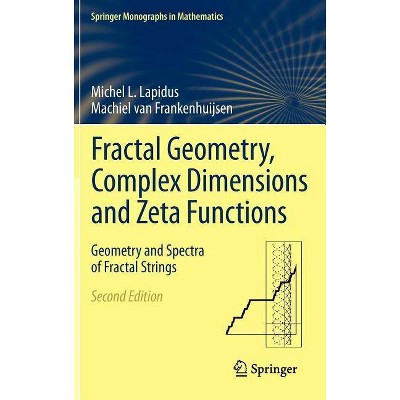
Similar Products
Products of same category from the store
AllProduct info
<p/><br></br><p><b> About the Book </b></p></br></br>In its Second Edition, this in-depth study of the vibrations of fractal strings interlinks number theory, spectral geometry and fractal geometry. Includes a geometric reformulation of the Riemann hypothesis and a new final chapter on recent topics and results.<p/><br></br><p><b> Book Synopsis </b></p></br></br><p>Preface.- Overview.- Introduction.- 1. Complex Dimensions of Ordinary Fractal Strings.- 2. Complex Dimensions of Self-Similar Fractal Strings.- 3. Complex Dimensions of Nonlattice Self-Similar Strings.- 4. Generalized Fractal Strings Viewed as Measures.- 5. Explicit Formulas for Generalized Fractal Strings.- 6. The Geometry and the Spectrum of Fractal Strings.- 7. Periodic Orbits of Self-Similar Flows.- 8. Fractal Tube Formulas.- 9. Riemann Hypothesis and Inverse Spectral Problems.- 10. Generalized Cantor Strings and their Oscillations.- 11. Critical Zero of Zeta Functions.- 12 Fractality and Complex Dimensions.- 13. Recent Results and Perspectives.- Appendix A. Zeta Functions in Number Theory.- Appendix B. Zeta Functions of Laplacians and Spectral Asymptotics.- Appendix C. An Application of Nevanlinna Theory.- Bibliography.- Author Index.- Subject Index.- Index of Symbols.- Conventions.- Acknowledgements.</p><p/><br></br><p><b> From the Back Cover </b></p></br></br><p>Number theory, spectral geometry, and fractal geometry are interlinked in this in-depth study of the vibrations of fractal strings; that is, one-dimensional drums with fractal boundary. This second edition of <i>Fractal Geometry, Complex Dimensions and Zeta Functions </i>will appeal to students and researchers in number theory, fractal geometry, dynamical systems, spectral geometry, complex analysis, distribution theory, and mathematical physics. The significant studies and problems illuminated in this work may be used in a classroom setting at the graduate level.</p><p>Key Features include: </p><p>- The Riemann hypothesis is given a natural geometric reformulation in the context of vibrating fractal strings</p><p>- Complex dimensions of a fractal string are studied in detail, and used to understand the oscillations intrinsic to the corresponding fractal geometries and frequency spectra</p><p>- Explicit formulas are extended to apply to the geometric, spectral, and dynamical zeta functions associated with a fractal</p><p>- Examples of such explicit formulas include a Prime Orbit Theorem with error term for self-similar flows, and a geometric tube formula</p><p>- The method of Diophantine approximation is used to study self-similar strings and flows </p><p>- Analytical and geometric methods are used to obtain new results about the vertical distribution of zeros of number-theoretic and other zeta functions</p><p>The unique viewpoint of this book culminates in the definition of fractality as the presence of nonreal complex dimensions. The final chapter (13) is new to the second edition and discusses several new topics, results obtained since the publication of the first edition, and suggestions for future developments in the field. </p><p>Review of the First Edition: </p><p>" The book is self contained, the material organized in chapters preceded by an introduction and finally there are some interesting applications of the theory presented. ...The book is very well written and organized and the subject is very interesting and actually has many applications." </p><p>--Nicolae-Adrian Secelean, <b>Zentralblatt</b></p><p> </p> <p><p>Key Features include: </p><p>- The Riemann hypothesis is given a natural geometric reformulation in the context of vibrating fractal strings</p><p>- Complex dimensions of a fractal string are studied in detail, and used to understand the oscillations intrinsic to the corresponding fractal geometries and frequency spectra</p><p>- Explicit formulas are extended to apply to the geometric, spectral, and dynamical zeta functions associated with a fractal</p><p>- Examples of such explicit formulas include a Prime Orbit Theorem with error term for self-similar flows, and a geometric tube formula</p><p>- The method of Diophantine approximation is used to study self-similar strings and flows </p><p>- Analytical and geometric methods are used to obtain new results about the vertical distribution of zeros of number-theoretic and other zeta functions</p><p>The unique viewpoint of this book culminates in the definition of fractality as the presence of nonreal complex dimensions. The final chapter (13) is new to the second edition and discusses several new topics, results obtained since the publication of the first edition, and suggestions for future developments in the field. </p><p>Review of the First Edition: </p><p>" The book is self contained, the material organized in chapters preceded by an introduction and finally there are some interesting applications of the theory presented. ...The book is very well written and organized and the subject is very interesting and actually has many applications." </p><p>--Nicolae-Adrian Secelean, <b>Zentralblatt</b></p><p> </p> <p>- Explicit formulas are extended to apply to the geometric, spectral, and dynamical zeta functions associated with a fractal</p><p>- Examples of such explicit formulas include a Prime Orbit Theorem with error term for self-similar flows, and a geometric tube formula</p><p>- The method of Diophantine approximation is used to study self-similar strings and flows </p><p>- Analytical and geometric methods are used to obtain new results about the vertical distribution of zeros of number-theoretic and other zeta functions</p><p>The unique viewpoint of this book culminates in the definition of fractality as the presence of nonreal complex dimensions. The final chapter (13) is new to the second edition and discusses several new topics, results obtained since the publication of the first edition, and suggestions for future developments in the field. </p><p>Review of the First Edition: </p><p>" The book is self contained, the material organized in chapters preceded by an introduction and finally there are some interesting applications of the theory presented. ...The book is very well written and organized and the subject is very interesting and actually has many applications." </p><p>--Nicolae-Adrian Secelean, <b>Zentralblatt</b></p><p> </p> <p> </p> <p>Key Features include: </p><p>- The Riemann hypothesis is given a natural geometric reformulation in the context of vibrating fractal strings</p><p>- Complex dimensions of a fractal string are studied in detail, and used to understand the oscillations intrinsic to the corresponding fractal geometries and frequency spectra</p><p>- Explicit formulas are extended to apply to the geometric, spectral, and dynamical zeta functions associated with a fractal</p><p>- Examples of such explicit formulas include a Prime Orbit Theorem with error term for self-similar flows, and a geometric tube formula</p><p>- The method of Diophantine approximation is used to study self-similar strings and flows </p><p>- Analytical and geometric methods are used to obtain new results about the vertical distribution of zeros of number-theoretic and other zeta functions</p><p>The unique viewpoint of this book culminates in the definition of fractality as the presence of nonreal complex dimensions. The final chapter (13) is new to the second edition and discusses several new topics, results obtained since the publication of the first edition, and suggestions for future developments in the field. </p><p>Review of the First Edition: </p><p>" The book is self contained, the material organized in chapters preceded by an introduction and finally there are some interesting applications of the theory presented. ...The book is very well written and organized and the subject is very interesting and actually has many applications." </p><p>--Nicolae-Adrian Secelean, <b>Zentralblatt</b></p><p> </p> <p>- Explicit formulas are extended to apply to the geometric, spectral, and dynamical zeta functions associated with a fractal</p><p>- Examples of such explicit formulas include a Prime Orbit Theorem with error term for self-similar flows, and a geometric tube formula</p><p>- The method of Diophantine approximation is used to study self-similar strings and flows </p><p>- Analytical and geometric methods are used to obtain new results about the vertical distribution of zeros of number-theoretic and other zeta functions</p><p>The unique viewpoint of this book culminates in the definition of fractality as the presence of nonreal complex dimensions. The final chapter (13) is new to the second edition and discusses several new topics, results obtained since the publication of the first edition, and suggestions for future developments in the field. </p><p>Review of the First Edition: </p><p>" The book is self contained, the material organized in chapters preceded by an introduction and finally there are some interesting applications of the theory presented. ...The book is very well written and organized and the subject is very interesting and actually has many applications." </p><p>--Nicolae-Adrian Secelean, <b>Zentralblatt</b></p><p> </p> <p> </p> <p>- Explicit formulas are extended to apply to the geometric, spectral, and dynamical zeta functions associated with a fractal</p><p>- Examples of such explicit formulas include a Prime Orbit Theorem with error term for self-similar flows, and a geometric tube formula</p><p>- The method of Diophantine approximation is used to study self-similar strings and flows </p><p>- Analytical and geometric methods are used to obtain new results about the vertical distribution of zeros of number-theoretic and other zeta functions</p><p>The unique viewpoint of this book culminates in the definition of fractality as the presence of nonreal complex dimensions. The final chapter (13) is new to the second edition and discusses several new topics, results obtained since the publication of the first edition, and suggestions for future developments in the field. </p><p>Review of the First Edition: </p><p>" The book is self contained, the material organized in chapters preceded by an introduction and finally there are some interesting applications of the theory presented. ...The book is very well written and organized and the subject is very interesting and actually has many applications." </p><p>--Nicolae-Adrian Secelean, <b>Zentralblatt</b></p><p> </p> <p> </p> <p> </p> <p>Key Features include: </p><p>- The Riemann hypothesis is given a natural geometric reformulation in the context of vibrating fractal strings</p><p>- Complex dimensions of a fractal string are studied in detail, and used to understand the oscillations intrinsic to the corresponding fractal geometries and frequency spectra</p><p>- Explicit formulas are extended to apply to the geometric, spectral, and dynamical zeta functions associated with a fractal</p><p>- Examples of such explicit formulas include a Prime Orbit Theorem with error term for self-similar flows, and a geometric tube formula</p><p>- The method of Diophantine approximation is used to study self-similar strings and flows </p><p>- Analytical and geometric methods are used to obtain new results about the vertical distribution of zeros of number-theoretic and other zeta functions</p><p>The unique viewpoint of this book culminates in the definition of fractality as the presence of nonreal complex dimensions. The final chapter (13) is new to the second edition and discusses several new topics, results obtained since the publication of the first edition, and suggestions for future developments in the field. </p><p>Review of the First Edition: </p><p>" The book is self contained, the material organized in chapters preceded by an introduction and finally there are some interesting applications of the theory presented. ...The book is very well written and organized and the subject is very interesting and actually has many applications." </p><p>--Nicolae-Adrian Secelean, <b>Zentralblatt</b></p><p> </p> <p>- Explicit formulas are extended to apply to the geometric, spectral, and dynamical zeta functions associated with a fractal</p><p>- Examples of such explicit formulas include a Prime Orbit Theorem with error term for self-similar flows, and a geometric tube formula</p><p>- The method of Diophantine approximation is used to study self-similar strings and flows </p><p>- Analytical and geometric methods are used to obtain new results about the vertical distribution of zeros of number-theoretic and other zeta functions</p><p>The unique viewpoint of this book culminates in the definition of fractality as the presence of nonreal complex dimensions. The final chapter (13) is new to the second edition and discusses several new topics, results obtained since the publication of the first edition, and suggestions for future developments in the field. </p><p>Review of the First Edition: </p><p>" The book is self contained, the material organized in chapters preceded by an introduction and finally there are some interesting applications of the theory presented. ...The book is very well written and organized and the subject is very interesting and actually has many applications." </p><p>--Nicolae-Adrian Secelean, <b>Zentralblatt</b></p><p> </p> <p> </p> <p>- Explicit formulas are extended to apply to the geometric, spectral, and dynamical zeta functions associated with a fractal</p><p>- Examples of such explicit formulas include a Prime Orbit Theorem with error term for self-similar flows, and a geometric tube formula</p><p>- The method of Diophantine approximation is used to study self-similar strings and flows </p><p>- Analytical and geometric methods are used to obtain new results about the vertical distribution of zeros of number-theoretic and other zeta functions</p><p>The unique viewpoint of this book culminates in the definition of fractality as the presence of nonreal complex dimensions. The final chapter (13) is new to the second edition and discusses several new topics, results obtained since the publication of the first edition, and suggestions for future developments in the field. </p><p>Review of the First Edition: </p><p>" The book is self contained, the material organized in chapters preceded by an introduction and finally there are some interesting applications of the theory presented. ...The book is very well written and organized and the subject is very interesting and actually has many applications." </p><p>--Nicolae-Adrian Secelean, <b>Zentralblatt</b></p><p> </p> <p> </p> <p> </p> <p>- Explicit formulas are extended to apply to the geometric, spectral, and dynamical zeta functions associated with a fractal</p><p>- Examples of such explicit formulas include a Prime Orbit Theorem with error term for self-similar flows, and a geometric tube formula</p><p>- The method of Diophantine approximation is used to study self-similar strings and flows </p><p>- Analytical and geometric methods are used to obtain new results about the vertical distribution of zeros of number-theoretic and other zeta functions</p><p>The unique viewpoint of this book culminates in the definition of fractality as the presence of nonreal complex dimensions. The final chapter (13) is new to the second edition and discusses several new topics, results obtained since the publication of the first edition, and suggestions for future developments in the field. </p><p>Review of the First Edition: </p><p>" The book is self contained, the material organized in chapters preceded by an introduction and finally there are some interesting applications of the theory presented. ...The book is very well written and organized and the subject is very interesting and actually has many applications." </p><p>--Nicolae-Adrian Secelean, <b>Zentralblatt</b></p><p><p/><br></br><p><b> Review Quotes </b></p></br></br><br><p>"This interesting volume gives a thorough introduction to an active field of research and will be very valuable to graduate students and researchers alike." (C. Baxa, Monatshefte für Mathematik, Vol. 180, 2016)</p><p>"In this research monograph the authors provide a mathematical theory of complex dimensions of fractal strings and its many applications. ... The book is written in a self-contained manner the results ... are completely proved. I appreciate that the book is useful for mathematicians, students, researchers, postgraduates, physicians and other specialists which are interested in studying the fractals and dimension theory." (Philosophy, Religion and Science Book Reviews, bookinspections.wordpress.com, April, 2013)<br></p><p></p><p>"The authors provide a mathematical theory of complex dimensions of fractal strings and its many applications. ... The book is written in a self-contained manner, the results (including some fundamental ones) are completely proved. ... the book will be useful to mathematicians, students, researchers, postgraduates, physicians and other specialists which are interested in studying fractals and dimension theory." (Nicolae-Adrian Secelean, Zentralblatt MATH, Vol. 1261, 2013)</p><p>"In this book the author encompasses a broad range of topics that connect many areas of mathematics, including fractal geometry, number theory, spectral geometry, dynamical systems, complex analysis, distribution theory and mathematical physics. The book is self containing, the material organized in chapters preceding by an introduction and finally there are some interesting applications of the theory presented. ...The book is very well written and organized and the subject is very interesting and actual and has many applications." -- Nicolae-Adrian Secelean for Zentralblatt MATH</p><p>"This highly original self-contained book will appeal to geometers, fractalists, mathematical physicists and number theorists, as well as to graduate students in these fields and others interested in gaining insight into these rich areas either for its own sake or with a view to applications. They will find it a stimulating guide, well written in a clear and pleasant style." -- Mathematical Reviews (Review of previous book by authors)</p><p>"It is the reviewera (TM)s opinion that the authors have succeeded in showing that the complex dimensions provide a very natural and unifying mathematical framework for investigating the oscillations in the geometry and the spectrum of a fractal string. The book is well written. The exposition is self-contained, intelligent and well paced." -- Bulletin of the London Mathematical Society (Review of previous book by authors)</p><p>"The new approach and results on the important problems illuminated in this work will appeal to researchers and graduate students in number theory, fractal geometry, dynamical systems, spectral geometry, and mathematical physics." -- Simulation News Europe (Review of previous book by authors)</p><br>
Price History
Cheapest price in the interval: 149.99 on November 8, 2021
Most expensive price in the interval: 149.99 on December 20, 2021
Price Archive shows prices from various stores, lets you see history and find the cheapest. There is no actual sale on the website. For all support, inquiry and suggestion messagescommunication@pricearchive.us
